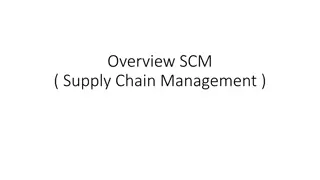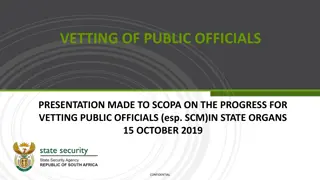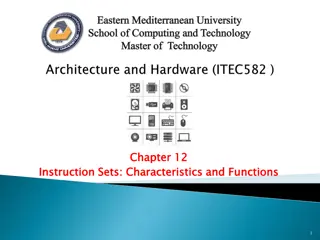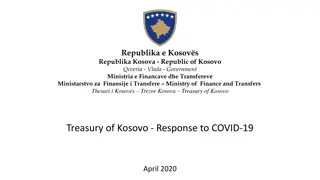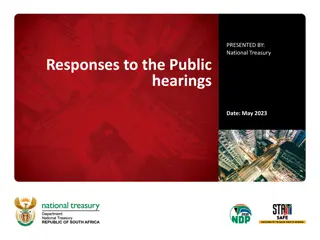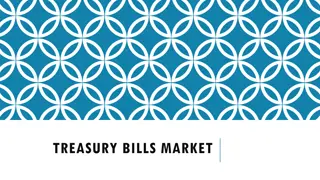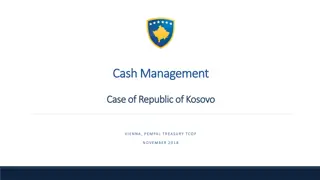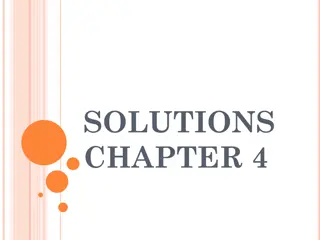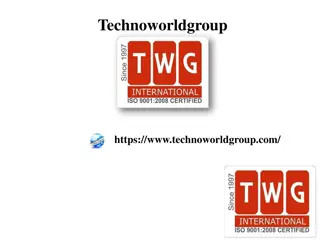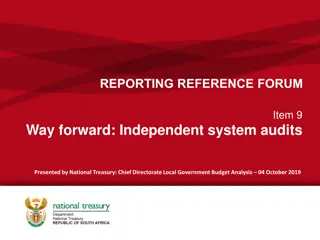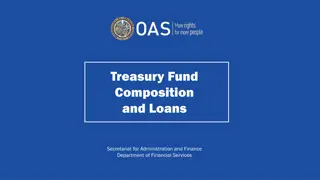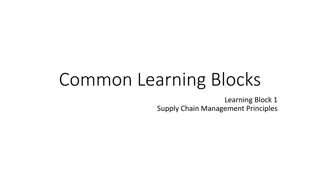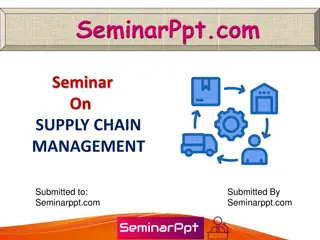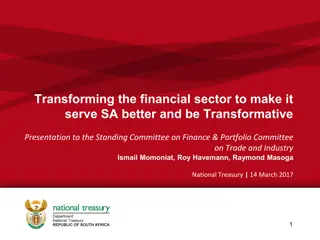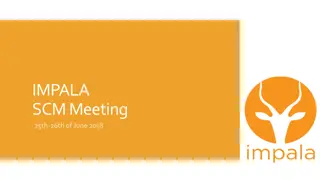Update on National Treasury SCM Instruction No. 03 of 2021/22
This presentation details the responsibilities of accounting officers as outlined in the PFMA Section 38. It emphasizes the need for effective financial management, internal controls, procurement systems, and transparency in resource utilization. The presentation aims to inform the Standing Committee on Public Accounts (SCOPA) about the key provisions of Instruction Note 3 of 2021/22, with a focus on enhancing compliance, transparency, and accountability in government entities.
Download Presentation

Please find below an Image/Link to download the presentation.
The content on the website is provided AS IS for your information and personal use only. It may not be sold, licensed, or shared on other websites without obtaining consent from the author.If you encounter any issues during the download, it is possible that the publisher has removed the file from their server.
You are allowed to download the files provided on this website for personal or commercial use, subject to the condition that they are used lawfully. All files are the property of their respective owners.
The content on the website is provided AS IS for your information and personal use only. It may not be sold, licensed, or shared on other websites without obtaining consent from the author.
E N D
Presentation Transcript
PRESENTED BY: ENHANCING COMPLIANCE, TRANSPARENCY & ACCOUNTABILITY MENDOE NTSWAHLANA CHIEF PROUREMENT OFFICER Update on the provisions of the National Treasury SCM Instruction No. 03 of 2021/22 22 November 2022
2 PURPOSE OF THE PRESENTATION The purpose of the presentation is to update the Standing Committee on Public Accounts (SCOPA) about Instruction Note 3 of 2021/22.
3 General Responsibilities of Accounting Officers PFMA Section 38 General responsibilities of accounting officers. (1) The accounting officer for a department, trading entity, or constitutional institution a) must ensure that that department, trading entity or constitutional institution has and maintains (i) effective, efficient and transparent systems of financial and risk management and internal control; (ii) a system of internal audit under the control and direction of an audit committee complying with and operating in accordance with regulations and instructions prescribed in terms of sections 76 and 77; (iii) an appropriate procurement and provisioning system which is fair, equitable, transparent, competitive and cost-effective; (iv) a system for properly evaluating all major capital projects prior to a final decision on the project; b) is responsible for the effective, efficient, economical, and transparent use of the resources of the department, trading entity, or constitutional institution; c) must take effective and appropriate steps to (i) collect all money due to the department, trading entity or constitutional institution (ii) prevent unauthorized, irregular and fruitless, and wasteful expenditure and losses resulting from criminal conduct and (iii) manage available working capital efficiently and economically
4 General Responsibilities of Accounting Officers d) is responsible for the management, including the safeguarding and the maintenance of the assets, and for the management of the liabilities, of the department, trading entity, or constitutional institution; must comply with any tax, levy, duty, pension, and audit commitments as may be required by legislation; must settle all contractual obligations and pay all money owing, including intergovernmental claims, within the prescribed or agreed period; on the discovery of any unauthorized, irregular or fruitless and wasteful expenditure, must immediately report, in writing, particulars of the expenditure to the relevant treasury and in the case of irregular expenditure involving the procurement of goods or services, also to the relevant tender board; must take effective and appropriate disciplinary steps against any official in the service of the department, trading entity or constitutional institution who e) f) g) h) (i) contravenes or fails to comply with a provision of this Act; (ii) commits an act that undermines the financial management and internal control system of the department, trading entity, or constitutional institution; or (iii) makes or permits an unauthorized expenditure, irregular expenditure or fruitless and wasteful expenditure; when transferring funds in terms of the annual Division of Revenue Act, must ensure that the provisions of the Act are complied with; i)
5 General Responsibilities of Accounting Officers j) before transferring any funds (other than grants in terms of the annual Division of Revenue Act or to a constitutional institution) to an entity within or outside government, must obtain a written assurance from the entity that that entity implements effective, efficient and transparent financial management and internal control systems, or, if such written assurance is not or cannot be given, render the transfer of the funds subject to conditions and remedial measures requiring the entity to establish and implement effective, efficient and transparent financial management and internal control systems; k) must enforce compliance with any prescribed conditions if the department, trading entity or constitutional institution gives financial assistance to any entity or person; l) must take into account all relevant financial considerations, including issues of propriety, regularity and value for money, when policy proposals affecting the accounting officer s responsibilities are considered, and when necessary, bring those considerations to the attention of the responsible executive authority; m) must promptly consult and seek the prior written consent of the National Treasury on any new entity which the department or constitutional institution intends to establish or in the establishment of which it took the initiative; and n) must comply, and ensure compliance by the department, trading entity or constitutional institution, with the provisions of this Act. SIMILAR PROVISIONS FOR ACCOUNTING AUTHORITIES OF PUBLIC ENTITIES IS FOUND IN SECTION 51 OF THE PFMA
6 Some of the contributing reasons for replacing Instruction Note No. 3 of 2016/17 Instruction Note 3 of 2016/17 dealing with the Prevention and Combating of the abuse of the SCM system was updated and replaced with SCM Instruction 3 of 2021/22 due to the following reasons: 1. To enhance transparency and accommodate the recommendations of the Zondo Commission of enquiry into state capture, Commission recommends that set standards of transparency consistent with the OECD Principles for integrity in public procurement be formulated by National Treasury for compulsory inclusion in every procurement system adopted by a public procurement entity. Introduction of procurement plans, advertising on etender portal, development of an instruction to provide further elaboration on TR16A6.6 which deals with the participation on contracts arranged by other organs of state, publishing of all deviations and contract modifications (variations and expansions) submitted to National Treasury, etc. 2. To improve turnaround time in decision-making and to expedite service delivery, particularly where the technical comprehension of the required process to be taken in line with the mandate of the institution is best placed with the institution. . During 2020/2021 it was found that there was an increasing number of applications for deviations, extensions and variations. This exacerbated the long turn-around times and stunted institutions in providing the services required, especially in SOCs and institutions with complex capital projects.
7 Some of the contributing reasons for replacing Instruction Note No. 3 of 2016/17 3. To provide expanded measures to restrict suppliers from doing business with the state on the basis other than fraudulent claims of preference points. During the review of the previous Instruction Note, it was established that when it comes to the restriction of suppliers for PFMA-related transgressions, the GCCs did not apply to the Schedules 2, 3B and 3D public entities, hence the gap in the case of these entities as Regulation 14 of the PPR, 2017 could ONLY be used to restrict a supplier for a transgression that is related to the fraudulent claims for preference points in terms of the PPPFA. 4. Hence in the new SCM Instruction 3 of 2021/22 the process to restrict a person or supplier from doing business with the state in terms of the PFMA has been provided for. 5. To provide measures for restricting and debarring employees of the state from doing business with government.
8 The approach adopted in developing Instruction 3 of 2021/2022 In developing Instruction note 3, the National Treasury adopted the following approach: 1. Ensure that, to the extent possible, the revised Instruction does not encroach on the institutional accountability conferred on Accounting Officers and Accounting Authorities in terms of the PFMA. 2. The Constitutional Court has held that conduct by an organ of state that has no foundation in some law breaches the principle of legality, which is a subset of the rule of law, a foundational value of the Constitution 3. In other words, Accounting officers/ Authorities are accountable for their own decisions, since in terms of the PFMA accountability vests with them.
9 The approach adopted in developing Instruction 3 of 2021/2022 (cont.) 4. National Treasury considered all inputs received in an attempt to find legally cognizable means, which in this case was to provide for reporting requirements that would strengthen the transparency of procurement within institutions, thus forcing Accounting Officers/Authorities to account for their decisions, which would serve as a deterrent against abuse of the SCM system. 5. These reports would be a useful tool for the National Treasury and relevant treasuries to identify areas of possible intervention and support and to strengthen compliance monitoring in the implementation of the PFMA. 6. To bridge the disparity between government departments, constitutional institutions, and public entities listed to the PFMA in Schedules 3A and 3C on the one hand, and Schedules 2 (SOCs) and 3B and 3D (government business enterprises) on the other hand within public procurement, created by the non-inclusion of SOCs and government business enterprises in Chapter 16A of the SCM Treasury Regulations.
10 The approach adopted in developing Instruction 3 of 2021/2022 (cont.) 7. To this end, the revised instruction differs somewhat from the strict format of being prescriptive, but has, in various areas, short of the narrative to provide context to the SOCs and government business enterprises, who are not governed by the General Conditions of Contract, standard bidding documents, etc. 8. Considered the inputs by stakeholders, some of which were conflicting, thus the National Treasury had to strike a balance between competing interests while maintaining respective legislative provisions.
11 Treatment of Disclosures and Declarations 1. Provides for institutions to identify and manage all potential conflicts of interest and other disclosures made by a person participating in procurement processes to enable the Accounting Officer/Authorities to make informed decisions about the person participating in the SCM process. 2. During the review process, National Treasury identified a number of inconsistencies in the broader public procurement regulatory framework, and there is an expectation that the procurement prescripts should resolve these inconsistencies. 3. For instance, the Public Administration Management Act, of 2014 defines what an employee and publicservice is and when reading these together, they exclude employees of SOCs. Therefore, to close this gap in the legislation, the new instruction extended the prohibition to do business with the state to employees of SOCs as well. 4. With regard to the extension of the application, the previous Standard Bidding Documents (SBD) 4, was not applicable to Schedules 2, 3B, and 3D public entities, but in terms of the new SCM Instruction 3 of 2021/2022, the SBD 4 includes these other entities as well.
12 Deviations from the normal bidding process and expansions/variations 1. The power to approve procurement by other means, i.e. deviations from inviting competitive bids, which includes limited bidding (sole source, single source), expansions/ variations, and written price quotations that fall outside the competitive bidding thresholds has been devolved to accounting officers/authorities (essentially returned to the AO/AA) and is no longer vested in the relevant treasuries. 2. The new Instruction provides for monthly reporting on procurement by other means ( deviations) to the relevant treasuries and the AGSA. 3. Moreover, a provision has been introduced in the Instruction to further provide for reporting in the institution s annual report where deviations from the competitive process have taken place. It thus elevates transparency and reduces any level of obscurity. 4. National Treasury has developed the Compliance Reporting Framework that will be issued by the OAG. 5. It is believed that these reporting interventions will enhance transparency, which is one of the major concerns raised in the Zondo Commission of Inquiry into the state capture report.
13 Enforcement of compliance to Bid Committee system 1. In light of several governance lapses which have subsequently been confirmed by the state capture Commissions, it became necessary to extend the bid committee system and enforce its implementation to also SOCs and government business enterprises. 2. This is an attempt to instil the culture of a bid committee system to avoid instances of abuse where, as articulated in the State Capture Report, it is indicated that certain projects were procured without the participation, knowledge, or approval of the business owners of those projects.
14 General requirements 1. The Accounting Officer/Authority may not invite price quotations or bids where no or insufficient provision has been made in the budget; must ensure that cash flow is sufficient to meet contractual obligations; must pay suppliers within 30 days of receipt of invoice or the period provided for in the contract; and may not place orders with suppliers for goods and services to be received in the current financial year and arrange with suppliers to be invoiced and payment to be made in the next financial year, except in the case of a multi-year contract. 2. Most of these provisions were included in the revised Instruction to emphasise the compliance requirements as these are some of the main areas that are abused, even though these are not necessarily procurement/ SCM provisions, but they play out in the SCM environment. Furthermore, some of these are contained in prescripts that are not applicable to Schedules 2, 3B, and 3D public entities, hence they were included here.
15 General comments and observations The revised instruction makes provision for reporting to the relevant treasuries and the Auditor-General of South Africa (AGSA), as well as in the institutions annual reports: The intention of the monthly reporting to the relevant treasury and AGSA is to ensure that where there are glaring matters of non-compliance, OCPO and those equivalent units in the provincial treasuries can act on it; and the AGSA may, in terms of section 5(1)(d) of the Public Audit Act, consider a special investigation or audit if the AGSA deems it to be in the public interest to do so, based on the report it receives from the institution. In other words, the rationale is to provide for transparency with the belief that early detection can assist with the intervention by National Treasury, the relevant treasury, and the AGSA, and even refer such cases to law enforcement agencies, if so required. The purpose of providing for reporting in the annual report is to ensure that the public also has access to this information and it is not hidden away in an obscure report that is difficult to access or even interrogate (and to also provide for ease of reference for the structures to whom AOs/AAs are required to report). Most of the remarks from the State Capture report have highlighted the lack of transparency when it comes to procurement processes, and the aim of these reports is to further enhance transparency. It is anticipated that transparency will also help to hold accounting officers / authorities accountable for the decisions that they take.
16 Repeal and withdrawal of Instructions, Practice Notes and Circulars 1. The following prescripts were considered in the review and will therefore be repealed by the instruction: National Treasury SCM Instruction Note 3 of 2016/17 Instruction Note No 32 dated 31 May 2011 related to enhancing compliance monitoring and improving transparency and accountability in Supply Chain Management. Supply Chain Management Circular postponing implementation of certain paragraphs in Instruction Note No 32 dated 31 May 2011 related to enhancing compliance monitoring and improving transparency and accountability in Supply Chain Management. Practice Note Number 7 of 2009/2010 dated 2 October 2009 and the SBD4 document Practice Note No SCM 5 OF 2006 on the restriction of suppliers and augmentation of general conditions of contract National Treasury Practice Note on the prohibition of restrictive practices: certificate of independent bid determination: standard bidding document. Practice Note No SCM 4 of 2006 on Standard Bidding Document: Declaration of bidder's past supply chain management practices. 2. This reduces the fragmentation in the public procurement / SCM regulatory environment and lessens the burden of complying with conflicting regulatory requirements by SCM practitioners as the issues that were contained in these prescripts are reduced to a single document.
17 Governance, Monitoring & Compliance New Instruction changes the manner in which deviations and variations are now processed and approved. DEVIATIONS FROM NORMAL BIDDING PROCESSES Did away with National Treasury or relevant treasuries granting approval /support to deviations from due procurement processes, Responsibility and accountability has been devolved and now vests with the AO/AA, AO/AAs must draft their own SCM policies and include procedures for procurement by other means Procurement by other means to be reported to the relevant treasury and the AGSA within 14 days after the finalization of the procurement; Procurement by other means (deviations) to be recorded in the institution s Annual Report. EXPANSIONS AND VARIATIONS OF CONTRACTS Did away with NT OCPO giving approval / support to expansions or variations Responsibility and accountability has been devolved and now vests with the AO/AA If construction-related contracts are expanded or varied by more than 20% or R20m; and Goods & Services contracts are expanded or varied by more than 15% or R15m (including all taxes), whichever is the lesser The AO/AA must submit monthly reports to the relevant treasury and AGSA Expansions and variations must be recorded in the institution s Annual Report
18 SOME OF THE DIFFERENCES BETWEEN THE TWO INSTRUCTIONS SCM INSTRUCTION NOTE 3 OF 2016/2017 PFMA SCM INSTRUCTION 3 OF 2021/2022 T Accounting Officers/Accounting Authorities must obtain prior approval from the relevant treasury for single-source procurement and any other means of procurement Authority to procure goods, services and or construction works, through other means, is conferred to the Accounting Officer/Accounting Authority (AO/AA) Sole source and emergency procurement methods are concluded by the AO/AA and reported to the relevant treasury All procurement through other means, are reported within the stipulated timeframe to the relevant treasury AO/AA may approve contract modifications below the stipulated thresholds, however, when the thresholds are exceeded the AO/AA must obtain prior approval from the relevant treasury All Officer/Authority regardless of the thresholds delegations are with the Accounting The deviations and contract variations if they exceeded prescribed thresholds. relevant treasury granted approval for Accounting officers/ Authorities and report all procurements through deviations, and contract variations and report regardless of the thresholds to relevant treasuries
19 Relevant treasuries role in Instruction 3 of 2021/2022 1. Enhance reporting tool (E-Tender Portal or similar) to extract and analyse trends, such as, Identify Institutions with a high number of deviations and contract variations, Determine the root causes of the deviations and variations (or other means of procurement ), Support institutions where specific trends are apparent, Provide advice on SCM procedures and practices, and Take immediate corrective action by intervening where there is evidence of persistent abuse of the system. 2. Access to the reports will be made available to all Provincial Treasuries, oversight bodies, and to the members of the public.
COMPARISONS BETWEEN Q1 & Q2 2021/2022 AND Q1 & Q2 2022/2023 20
DEVIATIONS 21
Top 20 Applications in Q1 of 2022-23 (PFMA SCM IN 3 OF 2021/2022) Top 20 Applications in Q1 of 2021-22 (SCM IN 3 OF 2016/2017) SABC R29,567,376.54 HSRC R604,318.79 DALRRD R33,324,693.89 ECIC R901,497.60 Denel R37,162,054.00 PanSALB R974,350.40 DEL R74,439,540.00 Mintek R1,794,473.94 Umgeni Water R83,200,000.00 DSD R2,000,000.00 DOT R86,466,069.20 SIU R2,486,400.00 USAASA R118,000,000.00 R5 500 614 098,14 R248 582 454,86 NRF R2,659,765.44 DHS R120,000,000.00 ARMSCOR R2,732,257.57 SASSA R120,865,681.20 SABC R2,825,741.48 SANSA R124,452,764.33 SAWS R3,284,413.80 AEMFC R127,000,000.00 LGSETA R3,500,000.00 SARS R148,093,669.52 SEDA R4,201,993.64 PRASA R188,086,800.00 DSBD R8,319,925.10 Rand Water R198,285,319.00 DWYPD R8,800,000.00 DPWI R215,673,598.47 SAPS R11,291,400.00 CGS R267,698,331.00 PetroSA R12,342,478.72 DEFF R451,763,615.00 S.A Tourism R13,121,800.90 Transnet R523,417,376.77 ESKOM DALRRD R685,120,124.93 R17,351,680.92 DCOG R763,042,100.62 CIPC R34,971,271.68 R1,104,954,983.6 7 DWS AEMFC R114,418,684.88 22 R- R500,000,000.00 R1,000,000,000.00 R1,500,000,000.00 R- R50,000,000.00 R100,000,000.00 R150,000,000.00
23 Comparisons Q1 (Old Instruction Note) vs Q1 (New Instruction Note) Analysis (Deviations): As noted in previous slide, there is a huge overall shift on the transaction total amount from R5.5 bn (Old) to R248 m (New). This can be due to institutions not procuring anymore using deviations (highly unlikely). This can also be due to institutions not reporting deviations as per the new Instruction Note (highly likely). Intervention: OCPO has instituted a process of writing to the institutions that were in the top 20 in the Old Instruction Note but no longer featuring in the New Instruction Note and ask if there were no transactions done through deviation process. Upon receipt of a no response, such institutions will be referred to the AGSA for a special audit process to verify if a no answer was indeed true, some have since reported but late. Upon a yes response, such transactions will be prioritised for site visits and bid reviews.
Top 20 Applications in Q2 of 2022-23 (PFMA SCM IN 3 OF 2021/2022) Top 20 Applications in Q2 of 2021-22 (SCM IN 3 OF 2016/2017) MLRF R12,660,100.00 HDA R50,593,601.12 S.A Tourism R13,483,090.52 SASSA R58,272,054.04 CGS R15,938,312.42 USAASA R60,000,000.00 DPME R16,700,000.00 SARS R69,439,800.84 FIC R17,225,005.75 SAPS R71,928,871.12 IEC R22,216,958.00 Rand Water R74,181,093.00 HSRC R25,813,241.72 SSA R85,933,787.00 Rand Water R28,091,415.37 DWS R103,479,942.95 NRF R28,636,336.94 Sentech R118,584,000.00 R7 175 724 798,18 R2 924 983 797,27 SAMRC R30,000,000.00 BBI R121,418,892.57 DWS R30,617,839.05 SITA R162,217,932.38 DEFF R33,437,540.00 RAF R165,028,722.60 GPW R37,883,506.69 DALRRD R184,331,862.27 PetroSA R51,529,980.92 AEMFC R236,000,000.00 CSIR R52,458,079.89 DEL R390,718,411.00 DBSA R70,020,430.03 DEFF R399,304,642.85 DLCA PRASA R78,764,630.04 R632,000,000.00 SABC AEMFC R866,206,983.20 R199,088,000.00 DCoG R1,526,084,201.2 4 Transnet R464,011,767.00 R1,800,000,000.00 DMV NHLS R1,696,407,562.93 R- R500,000,000.00 R1,000,000,000.00 R1,500,000,000.00 R2,000,000,000.00 R- R500,000,000.00 R1,000,000,000.00 R1,500,000,000.00 R2,000,000,000.00 24
25 Comparisons Q2 (Old Instruction Note) vs Q2 (New Instruction Note) Analysis (Deviations): As noted in previous slide, there is a huge overall shift on the transaction total amount from R7.1bn (Old) to R2.9bn (New). This can be due to institutions not procuring anymore using deviations (highly unlikely). This can also be due to institutions not reporting deviations as per the new Instruction Note (highly likely). Intervention: OCPO has instituted a process of writing to the institutions that were in the top 20 in the Old Instruction Note but no longer featuring in the New Instruction Note and ask if there were no transactions done through deviation process. Upon receipt of a no response, such institutions will be referred to the AGSA for a special audit process to verify if a no answer was indeed true. Upon a yes response, such transactions will be prioritised for site visits and bid reviews.
Top 20 Applications Q1 2022-2023 (PFMA SCM IN 3 of 2021/2022) Top 20 Applications Q1 2021-2022 (SCM IN 3 of 2016/2017) BANKSETA SANRAL R9,778,276.75 R30,000.00 ACSA DLCA R10,409,217.26 R74,316.56 ETDP SETA Legal Aid R13,760,632.20 R107,454.73 NPA ARMSCOR R16,191,029.16 R196,470.00 IPID NRF R17,642,457.60 R232,807.22 GPAA SANSA R19,613,651.35 R529,853.88 R285 630 020,60 R18 233 993 645,70 IEC TCTA R24,303,000.00 R723,442.29 Transnet LNW R41,409,522.00 R1,278,545.52 IRBA LGSETA R46,438,616.65 R1,965,801.60 SASSETA DPE R54,054,737.57 R2,471,907.21 NLC IUCMA R77,888,814.00 R3,003,449.00 DPWI CCMA R81,277,617.03 R3,529,892.53 SARS FIC R89,266,627.61 R5,057,986.33 SITA NSFAS R98,515,169.22 R8,140,539.88 DHA SIU R9,445,036.36 R124,149,236.00 DEL SAWS R14,055,338.97 R229,682,599.68 SAPO SACAA R15,148,566.00 R238,107,032.61 DEFF SARS R39,936,972.26 R360,301,227.10 NT SANRAL R1,795,072,912. 19 R51,803,643.93 Eskom DoJ&CD R14,886,131,269 .72 R127,897,996.33 R- R5,000,000,000.00 R10,000,000,000.00 R15,000,000,000.00 R20,000,000,000.00 R- R50,000,000.00 R100,000,000.00 R150,000,000.00 27
28 Comparisons Q1 (Old Instruction Note) vs Q1 (New Instruction Note) Analysis (Contract Modifications): As noted in previous slide, there is a huge overall shift on the transaction total amount from R18 bn (Old) to R285 m (New). This can be due to institutions not doing contract modifications anymore (highly unlikely). This can also be due to institutions not reporting contract modifications as per the new Instruction Note (highly likely). Intervention: OCPO has instituted a process of writing to the institutions that were in the top 20 in the Old Instruction Note but no longer featuring in the New Instruction Note and ask if there were no contract modifications done. Upon receipt of a no response, such institutions will be referred to the AGSA for a special audit process to verify if a no answer was indeed true, some have since reported but late. Upon a yes response, such transactions will be prioritised for site visits and bid reviews.
Top 20 Applications Q2 2021-2022 (SCM IN 3 of 2016/2017) Top 20 Applications Q2 2022-2023 (PFMA SCM IN 3 of 2021/2022) SACAA R58,680,337.00 SANBI R13,649,296.59 Denel R117,318,660.00 PRASA R18,202,965.12 ACSA R121,883,946.0 0 GPW R18,942,967.00 HSRC R132,573,910.0 0 SANParks R19,154,782.26 TCTA R149,551,213.0 0 DALRRD R21,000,000.00 CSIR R241,499,416.0 0 DBSA R22,069,649.64 R110 150 673 026,95 Transnet R5 187 415 630,98 R243,497,750.0 0 DoH R23,693,549.03 R282,731,057.0 0 AEMFC UIF R23,721,693.00 SSETA R391,513,755.0 0 SABC R27,203,231.14 merSETA R514,390,022.0 0 NDA R30,150,000.00 Brand SA R587,201,181.0 0 DoJ&CD R31,057,000.00 RTMC R600,949,584.0 0 SIU R31,107,699.00 UIF R1,697,465,551.00 MISA R32,410,913.99 GPW R1,999,300,415.00 Magalie R57,942,350.00 DPWI CCMA R84,096,706.02 R2,043,268,736.00 SARS R113,302,422.26 DOT R3,543,021,594.00 SAPO R218,264,779.89 SARS R5,940,896,883.00 SASSA R387,375,910.74 DWS R6,275,086,810.00 Eskom R865,569,715.30 SASSA R7,887,105,026. 00 DHA Eskom R77,322,737,180.95 R3,148,500,000.00 R- R1,000,000,000.00 R2,000,000,000.00 R3,000,000,000.00 R4,000,000,000.00 R- R40,000,000,000.00 R80,000,000,000.00 29
30 Comparisons Q2 (Old Instruction Note) vs Q2 (New Instruction Note) Analysis (Contract Modifications): As noted in previous slide, there is a huge overall shift on the transaction total amount from R5.1 bn (Old) to R110 bn (New). This can be due to institutions doing more contract modifications (highly likely), as the main contributor on this one is clearly Eskom with R77 bn alone. This can also be due to institutions not reporting contract modifications as per the new Instruction Note (highly likely). Intervention: National Treasury will be writing to the institutions that were in the top 20 in the Old Instruction Note but no longer featuring in the New Instruction Note and ask if there were no contract modifications done. Upon receipt of responses, such institutions will be referred to the AGSA for a special audit process to verify the correctness of information received. In addition, National Treasury will conduct its own physical verification in this regard including in loco inspections.



